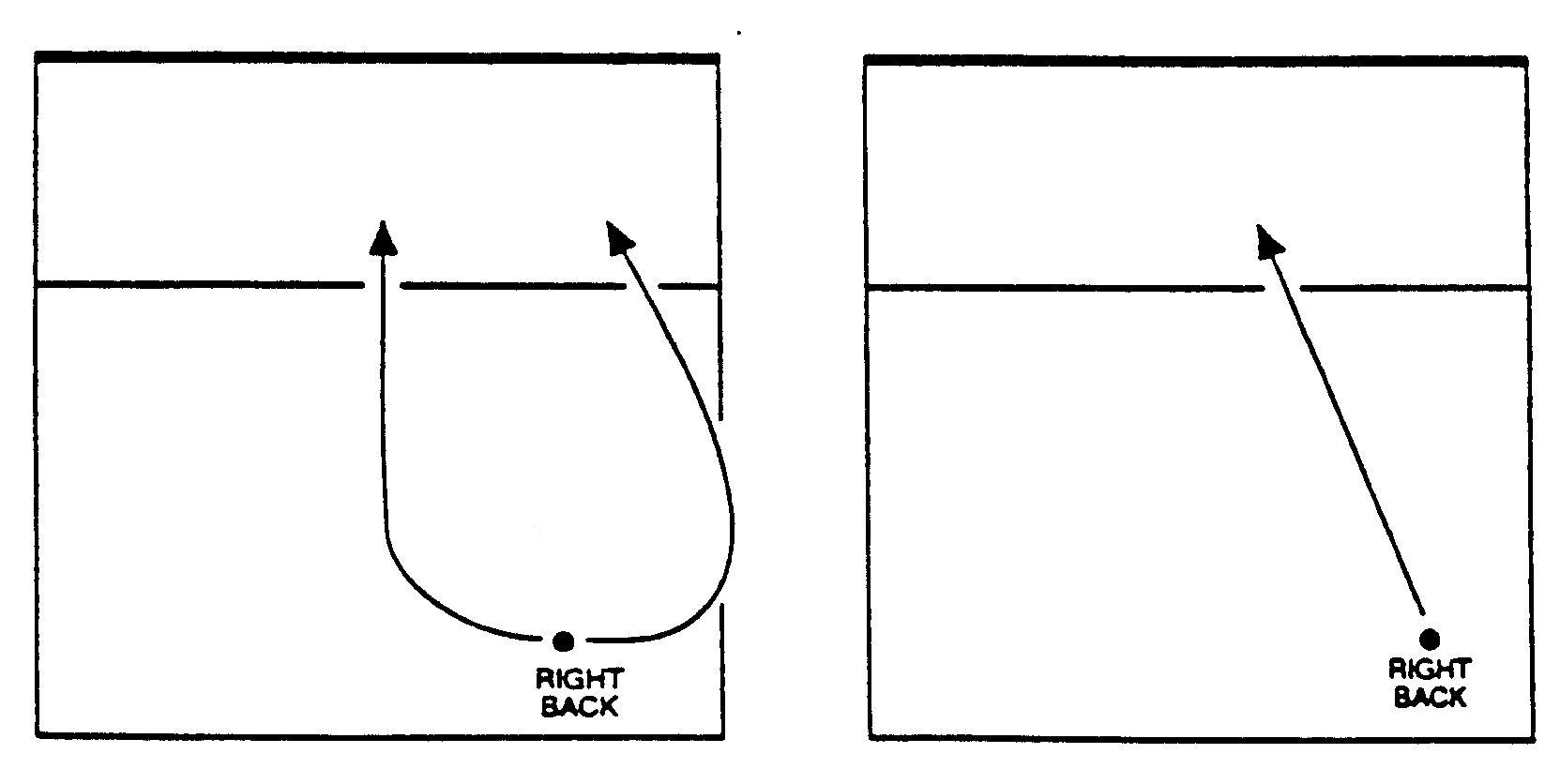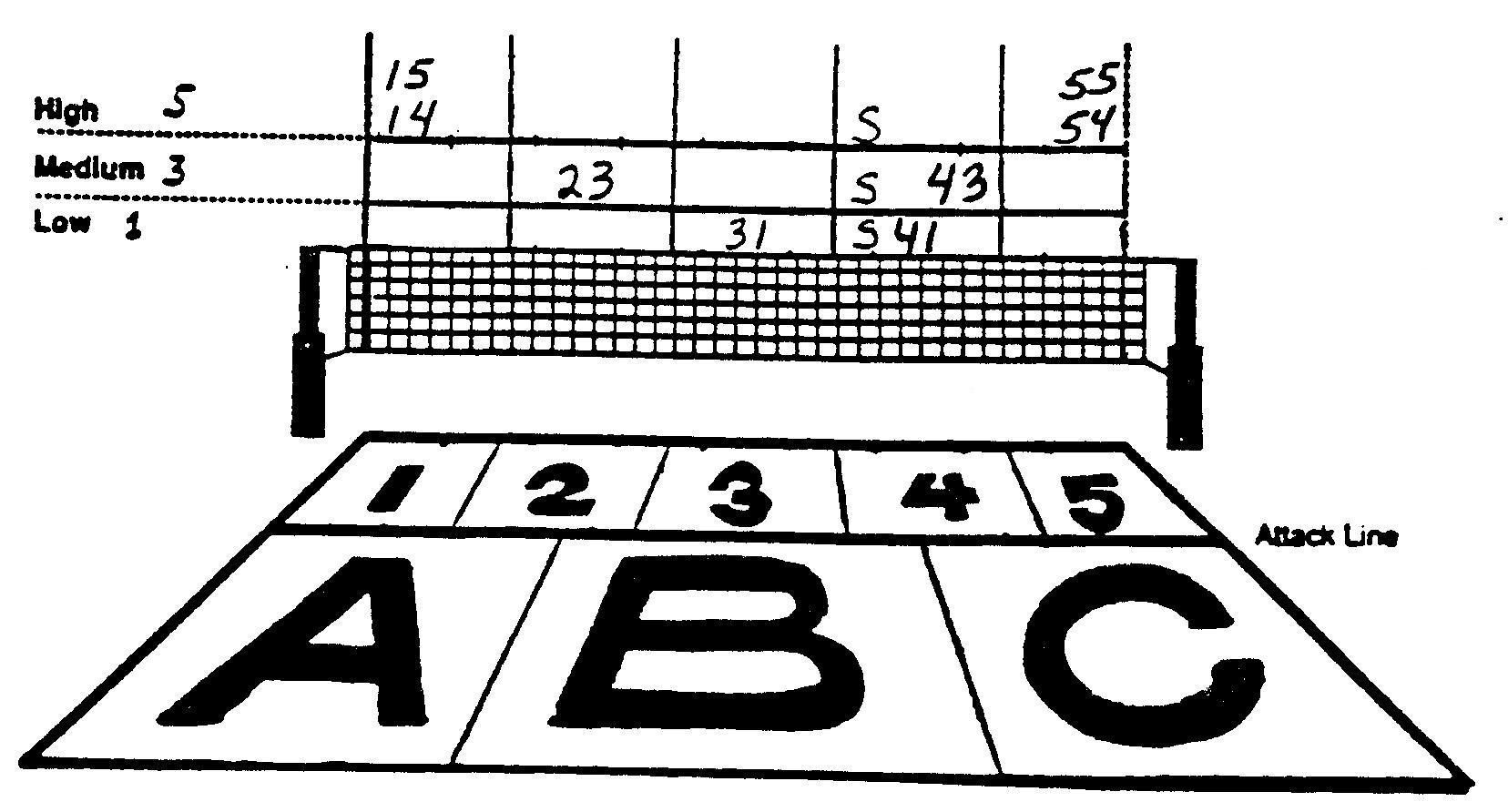
Individual attack tactics are those strategical maneuvers executed by a single hitter. It is the reactive but thought out efforts to beat the block and the opponent's team defense. The attacker is relying only on her own wits and physical ability to "kill" the set delivered to her.
FUNDAMENTAL OR IDEAL SPIKER'S APPROACHES
(For a right handed hitter)
The ideal approach to spike consists of: (1) a straight line for balance; (2) 3-4 steps for control and speed; and (3) a good angle to the net for range.
A spiker can use seven variations of the ideal approach to place herself in an optimum position to hit the set for a kill: the loop, the short pattern, the glide, the quick slide, the one-foot slide, the broad-jump, and the creep.
1. The Loop. The most common change is for the spiker to follow a looped path toward the attack point. In this technique, a hitter uses a curved approach, either left-to-right or right-to-left to line herself up with the setter or with a specific point of attack. This curved approach provides a wider range of attack points along the net either in front of or behind the setter.
2. The Short Pattern. The spiker may change the distance between each of her steps or eliminate one or two steps to be able to quickly attack a set. Starting closer to the net or having to attack quickly while in transition from defense to offense are examples where this technique could be used.
3. The Glide. A hitter who needs to travel a great distance to reach her point of attack will use this technique. In this technique, the first two steps are longer and faster than if using a normal approach.
4. The Quick Slide. The quick slide is a technique in which a single attacker both fakes and attacks in short succession. The attacker nears one point on the net and then moves sideways-slides-to another. For example, the middle front hitter approaches as if she intends to hit a quick one ball. She plants her feet normally and then broad jumps to the left along the net. She receives a quick front shoot that is just past the middle front blocker's arms.
5. The One-footed Slide. The one-footed slide differs from a regular quick attack in that the attacker fakes a quick and then attacks a play set, a two ball. Jumping from one foot allows the attacker to travel a greater distance along the net. A one-footed slide can also be use by a hitter in transition to quickly attack a ball or to attack a ball that is set to far away to use an ideal technique.
6. The Broad Jump. The attacker jumps both high and forward to reach a set ball. Quick sliders can use the broad-jump technique. So can back row players who like to have the ball set closer to the net rather than past the ten-foot line.
7. The Creep. In this final variation on the ideal approach, the spiker adjusts her starting position with short steps, often to the side, as she watches the ball. The combination of the distance to the attack point and the quickness of the set prevents the hitter from starting in her usual position.
Numbering the Individual Plays
Teams can develop specific plays for its hitters. In order for coaches and players to communicate, the following numbering system was devised. This numbering system is specific about the type or height of the set and the location on the net of the set.
Regarding the set's location, the net is divided into five imaginary attack zones. Each zone is about six feet wide and has a number associated with it. The system numbers the zones one through five, from the left sideline to the right sideline. The far left is one, the far right is five and the setter is located in zone four.
In addition to the front row attack zones, the back row is divided into three imaginary attack zones. Each zone is ten feet wide and has a letter associated with it. The left side is "A", the middle is "B" and the right side is "C."

Another number is added to the location number and this designates the type or height of the set. Thus a "31" is a low set in zone 3, a middle hitter's quick attack. A "15" is a high set to zone one, to the left outside hitter. A "54" is a medium to high outside set to zone 5, to the right outside hitter,
Players are reminded that this system is not exact. Attack points can become difficult to determine when the ball is passed to the left or right of the setter's ideal position. This system is only devised to permit players and coaches to communicate. Players do not necessarily base their approaches and movement patterns on imaginary net and court zones. Players must adjust their positions due to their relationship to the ball, their teammates, and the net.
In such a situation, a specific play combination can still be completed but the hitters must make adjustments to their approach patterns, relative to the setter's position, to receive the predetermined set.
The Left Front Hitter
Ideal Starting Position
The left-front hitter's ideal starting position is 12 feet off the net and from the sideline to 4 feet outside the court. The majority of her attacks are medium height along the net or high sets on the left sideline.
Approaches and Plays
The left-front has three primary Approaches and plays.
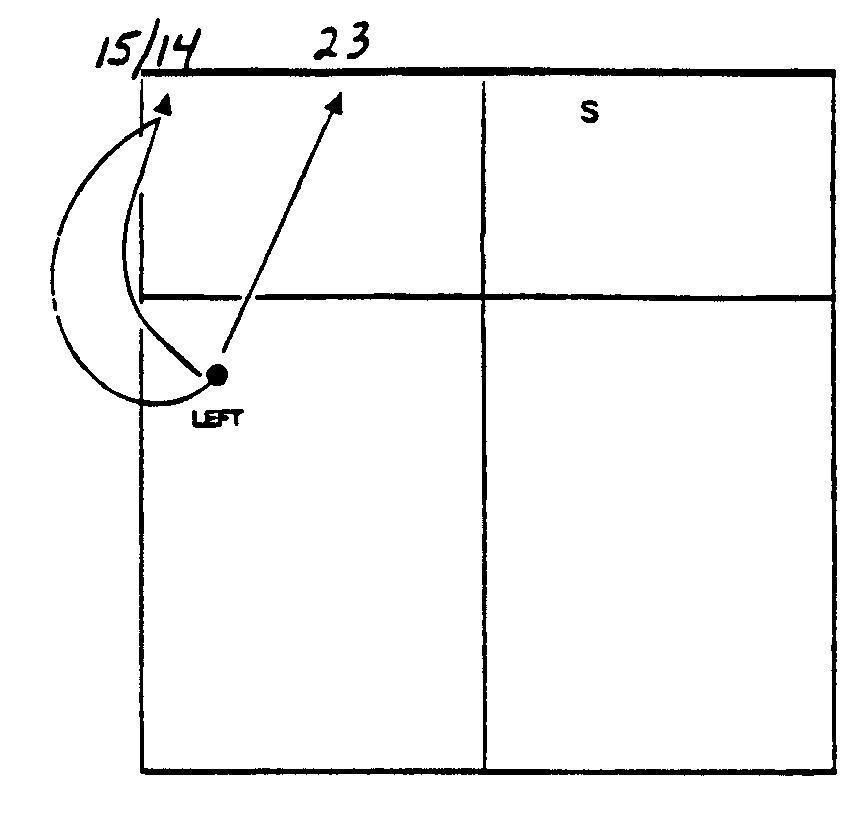 1.
The Three (Inside shoot, 23.) In attacking the three, the left front hitter
uses a straight line approach. This attack allows for balance and the best angle
of arrival. The setter to hitter timing has the left front jumping to attack
the ball as the setter is touching the ball.
1.
The Three (Inside shoot, 23.) In attacking the three, the left front hitter
uses a straight line approach. This attack allows for balance and the best angle
of arrival. The setter to hitter timing has the left front jumping to attack
the ball as the setter is touching the ball.
2. The Four (Outside shoot, 14.) The left front hitter usually attacks the four set with a straighter approach than she normally does to attack higher and slower sets in the same location. She does not have time to position herself outside the court, especially if she receives the serve. If she does not pass, she creeps or sidesteps left to increase her angle. The timing on the four ball has the left front hitter taking her last two (right-left) steps as the setter is touching the ball.
3. The Five (High outside, 15.) Takes place on the left sideline. The left front hitter takes her ideal starting position and uses a 3-4 step approach angled toward the right corner of the opponent's court. If the left front passes the ball, she can use a loop technique to get to her starting position. If she is not passing the ball, she can use sidesteps to the left to get to her starting position.
Middle Attacker
Ideal Starting Position:
If the middle hitter is not involved in serve reception or is in transition from defense to offense, she should quickly move to her ideal starting position once the ball travels past her position. The middle hitter's ideal starting position is closer to the net than the other hitters. The middle hitter positions herself left of the setter, on or slightly deeper than the 10-foot attack line, about halfway between zones two and three. The middle hitter locates the ball by pivoting on her left foot so she is able to see the passer, the setter, the blockers and the opponent's court.
The middle uses a two or three step approach for most of her attacks, which are of the quick variety. The middle attacker must time her approach so that she reaches her take off point as the ball is touched by the setter. The middle attacker never goes past the imaginary line created by the setter's feet and the net. Her take-off point is actually two to three feet from the net and to the side of the setter. The jump must be vertical and she contacts the ball at it's high point.
The Arm Swing:
It is important that the quick-hitter get her hitting arm up as quickly as possible to provide a target for the setter. The shoulders are at a 45 degree angle to the net with the hips perpendicular to the net. The ball is hit after a quick, short, upright, arm swing since the big wind-up is not possible or desirable. The ball should be contacted as consistently high as possible, therefore middle hitters should learn to become comfortable with a "slow" as well as a "fast" set. If the pass to the setter is unusually quick and the attacker is slightly behind the ball, the setter can control the tempo and rhythm of attack sequence by delivering the set by jumping or crouching down, etc. A "slow" 31 must be cut left or right to avoid the block. The tactical aspect of the attack is mostly wrist action with little time for shoulder rotation. (The setter, in certain situations, may lead the hitter back to her left shoulder to force a rotation to get by an over playing block.)
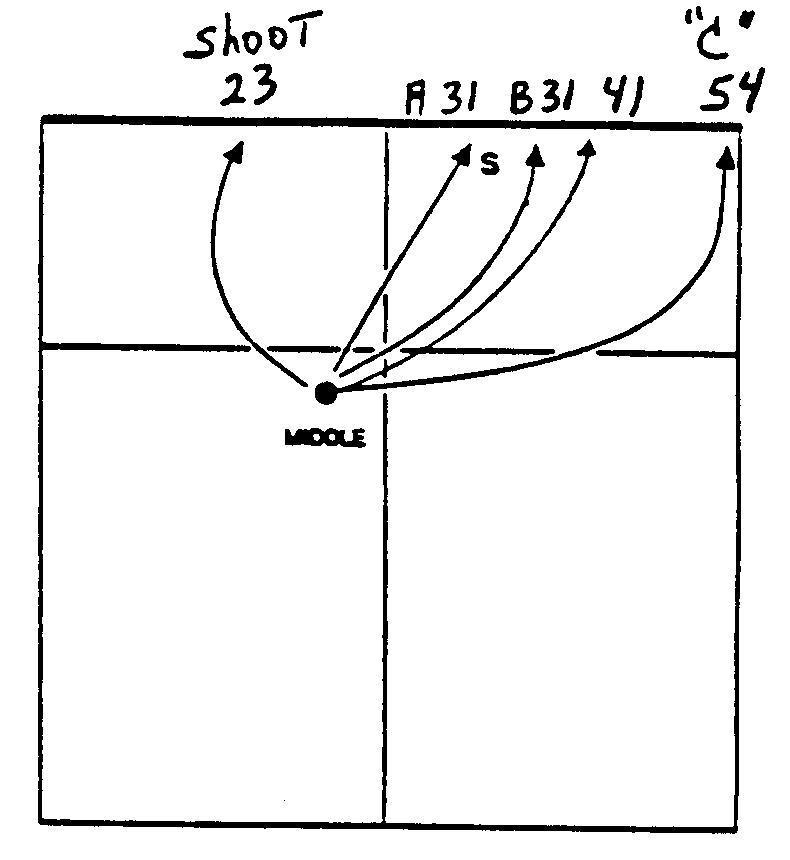 Approaches
and Plays
Approaches
and Plays
The middle attacks four low, quick sets.
1. The One (Quick, 31.) The middle's starting position allows a straight, balanced approach for the one ball. The middle hitter attacks the one set from her ideal position. It is not unusual for the middle hitter, particularly if she is tall, to move from her starting position to her jump in two steps.
2. The Back One (Back-quick, 41.) The back one requires an initial loop from right to left behind the setter and then a straight approach. The spiker's last two steps are straight and offer a good angle of attack.
3. The Back One-Footed Slide (Outside shoot, 54.) A frequently used isolation attack by the middle hitter; also takes place to the right of the setter. The middle attacks a shoot set or four ball set towards the right sideline. Because of the distance, the middle hitter must creep right and then loop. Her last step is with her left foot, from which she takes off, and then broad jumps to the ball.
4. The Three (Inside shoot, 23.) The middle hitter can not use a straight approach for the three ball. She must loop from left to right in order to attack back toward the right with power.
The Right Front
Ideal Starting Position
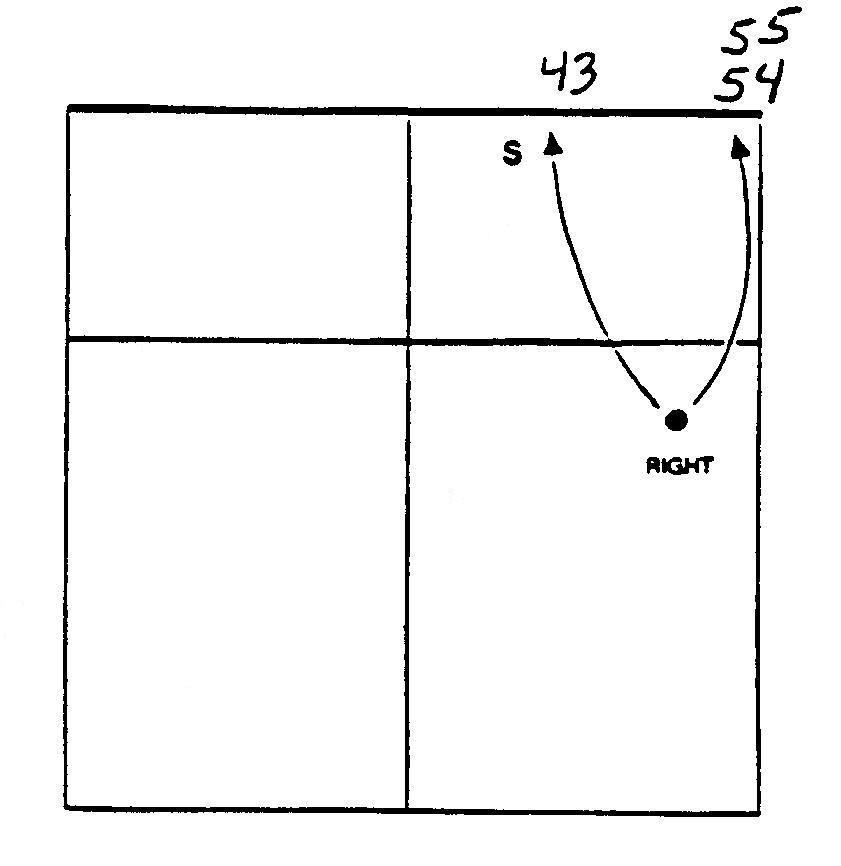 The
ideal starting position for the right front hitter is 12 feet off the net and
from the sideline to 4 feet inside the court. The majority of her attacks are
of medium height along the net or high sets on the right sideline.
The
ideal starting position for the right front hitter is 12 feet off the net and
from the sideline to 4 feet inside the court. The majority of her attacks are
of medium height along the net or high sets on the right sideline.
Approaches and Plays
The right front has three primary approaches.
1. The Three (Inside shoot, 43). The right front hitter usually attacks the three set with a straighter approach than she would normally use when the set is higher and slower in the same location. If she receives the serve, she must loop to the left to get into a proper approach angle. If she does not pass, she creeps or sidesteps left to get into a proper approach angle. The setter to hitter timing has the right front jumping as the setter touches the ball.
2. The Four (Outside shoot, 54). Takes place near the right Sideline. The right front hitter often does not have time to gain much of an outside-in angle on the shoot set. She approaches nearly perpendicular to the net. The setter to hitter timing has the right front going into her last two steps (right-left) as the setter is touching the ball. She contacts the ball just inside the right sideline, where she has the maximum range to hit either the line or crosscourt.
3. The Five (High outside, 55). Also takes place on the right sideline. The right front hitter takes an slight outside-in angle on the high outside set. She contacts the ball just inside the right sideline, where she has the maximum range to hit either the line or crosscourt.
Back Row Approaches
The back row attackers will be hitting high release sets. There is no need for faking in the approach as the front row play action is designed to screen back row movements.
The approach can be made from any distance but the last three steps are the same as in any fundamental attack. The lift off should be just behind the 10 foot line with the left foot closest to the net. The hitter broad jumps to the set ball.
The setter to hitter timing is based on the design of the play and height and depth of the set.
The position of this set is approximately seven feet back from the net. The back row hitter must long jump to the ball.
The Left Back
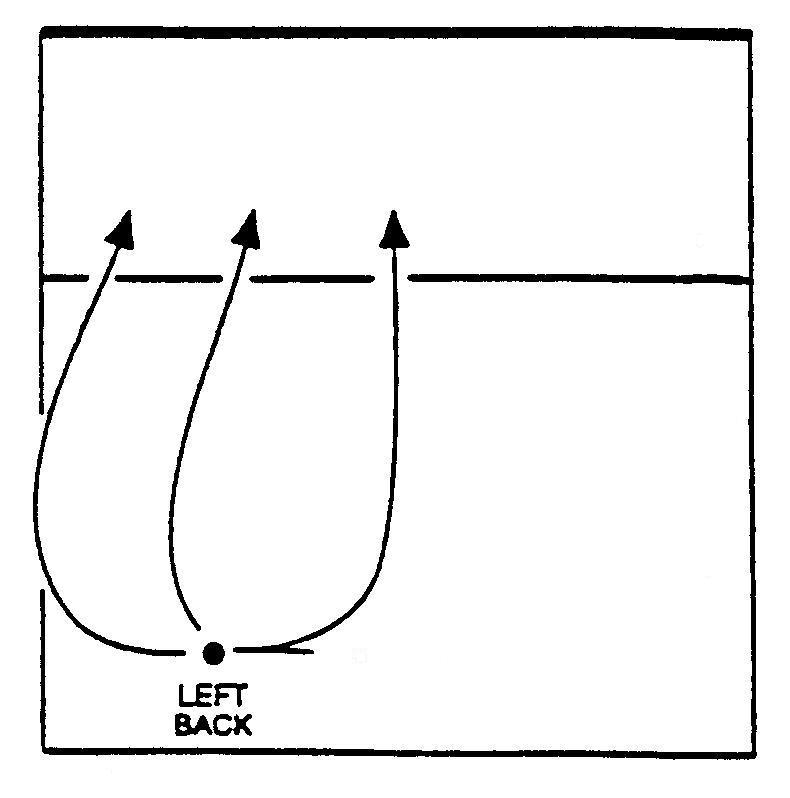 The
left back's sideline approach is similar to the left front in attacking a medium
height or high set on the sideline. The left back starts near the sideline and
angles to the right. The left back contacts the ball slightly inside the sideline.
The
left back's sideline approach is similar to the left front in attacking a medium
height or high set on the sideline. The left back starts near the sideline and
angles to the right. The left back contacts the ball slightly inside the sideline.
In order to hit in line with the attack at the two slot, the left back first sidesteps to the right and then heads straight, at a slight angle, toward the net.
For a middle attack, the left back loops toward the midline and then takes a perpendicular approach to the net.
The left back, like all the other back row hitters, broad jumps toward the ball. She contacts the ball between the attack line and the net.
The Middle Back
The middle back attacks mostly from the midline of the court. Her approach is perpendicular to the net. The middle back broad jumps toward the ball and contacts the ball between the attack line and the net.
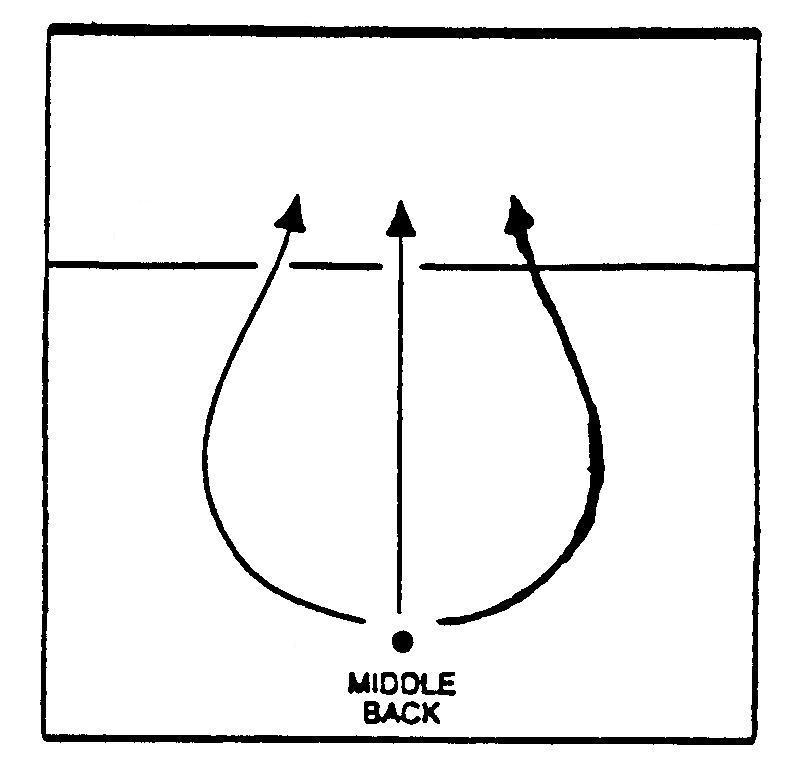
The Right Back
The right back is the most commonly used back row attacker with the setter in the front row. With the setter in the front row, the front row attackers usually are positioned to the middle and left. This means that the setter, in order to spread the attack along the net, delivers the ball to the right back.
The right back will attack the ball with a slight outside-in approach. The right back can also loop left and attack from the middle. The right back's approach is perpendicular to the net. The right back broad jumps toward the ball and contacts the ball between the attack line and the net.
